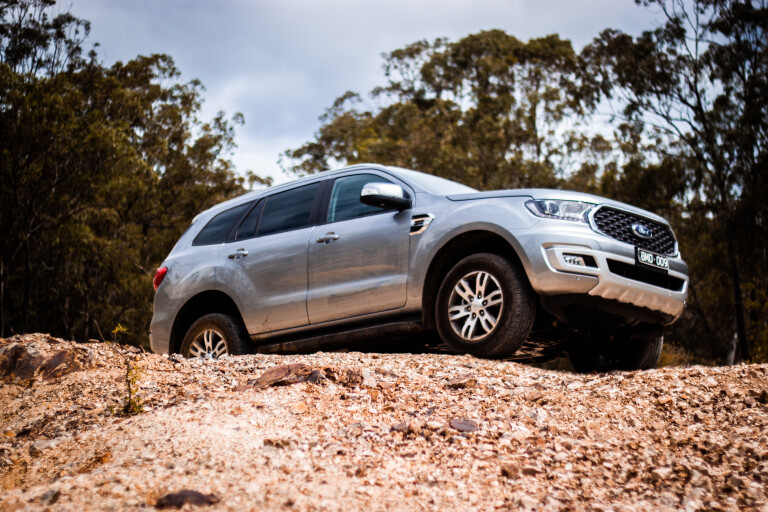
Score breakdown
Things we like
- Cargo space with seats down
- SYNC3 infotainment system is a winner
- Extremely competent off-road
Not so much
- Appearance has barely changed for years
- 10-speed automatic hunts for the right gear at times
- No reach adjustability for steering wheel
With the all-new Ford Ranger set for 2022, it can be assumed a brand spankers Everest is hot on our heels. So it begs the question: Is the updated 2021 Ford Everest still relevant, or is it a bit long in the tooth?
The sizzling dual-cab 4x4 market leads the charge Down Under, and has for some time, dealing every other vehicle segment belting after belting. But the 4x4 wagon sales race represents the dawn of our love for off-roading and remains hotly contested.
UPDATE, September 13, 2022: New Ford Everest on sale, and we've driven it!
The new-generation 2023 Ford Everest is finally on sale in Australia, and our man Matt Raudonikis has driven it. Get the full story, and our first-drive video, at the link below.
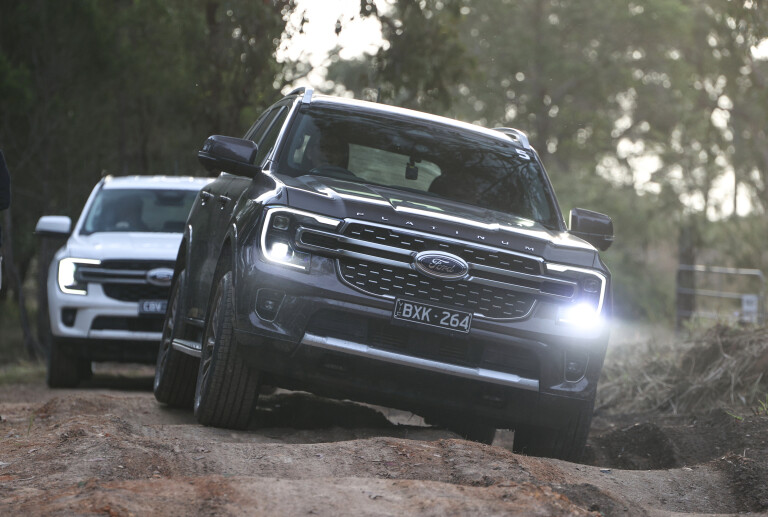
Story continues...
What was once the dedicated 4x4 wagons’ domain is now shared by ute-based SUVs from the likes of Ford, Mitsubishi, Isuzu, and segment frontrunner Toyota with the HiLux-based Fortuner to complement its market-dominating Prado.
The intended design task, clearly, was to offer the benefits of a proven dual-cab ute model but in practical wagon form and without many of the ute-related downsides.
Back in 2016 we first started seeing the Ford Everest on Aussie roads, in fact, it was specifically engineered for our less-than-perfect blacktop and front-on it looked every bit a Ford Ranger.
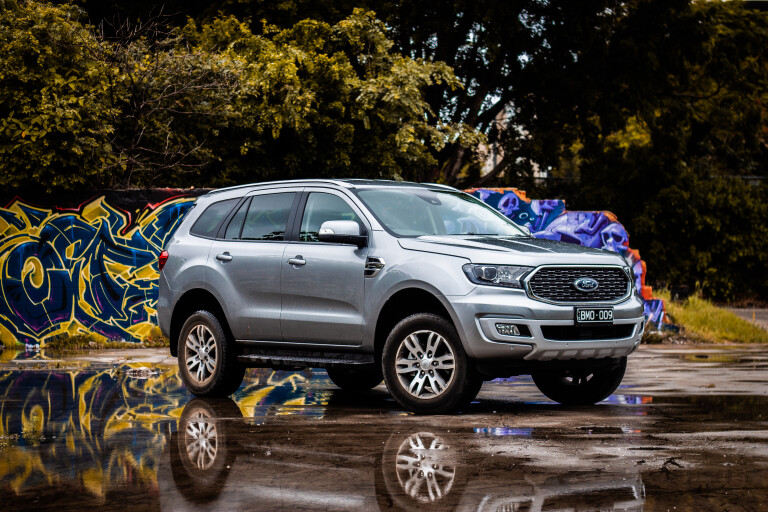
Ford took the top-selling Ranger to finishing school, giving it modern manners by doing away with the tray, smartening the whole package up and running head-on at the SUV market.
The Everest goes further than a change of clothes, though, offering a heavily re-engineered package with perks like coil springs all round, seven seats, constant four-wheel-drive, and dedicated SUV comfort.
But the Everest has, aside from scoring the 2.0-litre Bi-Turbo/10-speed powertrain from the Ranger, remained largely unchanged since 2016.
Sure, small improvements have been offered each year, but it’s ultimately a pretty dated package with a hefty price tag, and up and down sales figures reflect this.
With all that said, the Everest is a strong contender and while it is the exxiest ute-based option, it’s arguably still the best.
Now unless you’ve been living under a rock, you’ll know that the all-new 2022 Ranger was revealed recently. So, why test the ’21 Everest?
For starters, the 2.0-litre Bi-Turbo/10-speed powertrain will carry over to the new model and, on top of that, it naturally takes punters a bit of time to warm up to all-new models.
If you’re one of the many people that is still open to a previous-gen model, tried and tested in the line of duty, or perhaps you prefer the look of the current Everest, then read on.
Outside and In

While visual changes are kept to a minimum for 2021, consisting solely of an updated chrome grille for Trend and Titanium models, the Everest still looks the part – a strong mix of city SUV and weekend fourby.
As far as the exterior goes, it’s much of the same for the Trend model, with auto-levelling Bi-LED headlights that have daytime runners, and the same 18-inch alloys carried over from 2020, as well as privacy glass for the second and third rows.
A power tailgate is still standard but hands-free functionality has been dropped unless you fork out more of your heard-earned for the Sport or Titanium model.
From the driver’s seat, the Everest spoils you with all the tech you’ll need in a 4x4 wagon, sensible ergonomics and functionality throughout.
And on seating, yep, there’s seven of them. Our tester was optioned with the premium pack, which brings power-folding rear seats and a full-size spare alloy wheel. A handy feature if you’re constantly folding down the rear, perhaps useful for Uber drivers or adventurous families.
The one ergonomic drawback is the lack of reach adjustability for the steering wheel. More on that later.
An 8.0-inch touchscreen sits front and centre with the usual Apple CarPlay and Android Auto functionality, backed by eight speakers which, when combined with Ford’s active noise cancellation, provide plenty of doof.
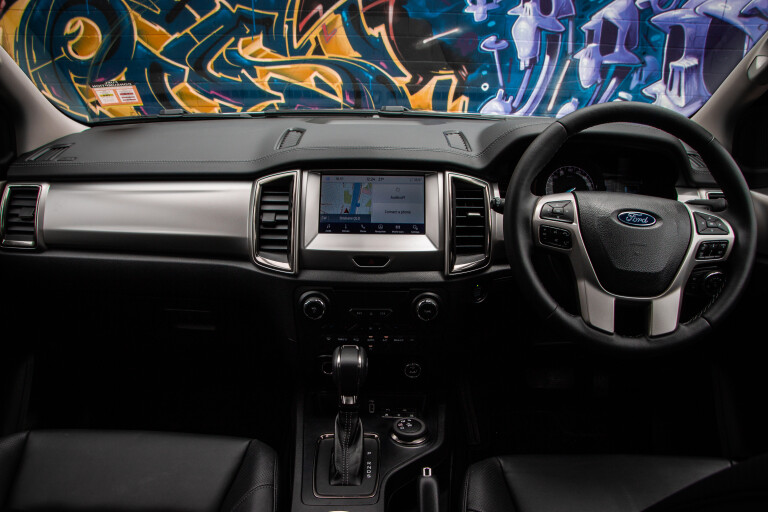
The Everest uses the excellent SYNC3 infotainment system Ford co-developed with Google, which is good enough to use on its own instead of just opting for phone mirroring by default.
Ample USB ports and 12V sockets are available throughout the cabin, including a handy 230V inverter in the rear console.
Seven airbags keep occupants safe and land the Everest its five-star ANCAP safety rating, coinciding with an impressive array of standard safety tech to bring it in line with the best of them.
In fact, the Everest covers all bases when it comes to safety tech, with the standard inclusion of autonomous emergency braking with forward collision alert, hill launch assist, pedestrian protection, adjustable speed limiter, belt minder for first- and second-row occupants, dynamic stability control, emergency brake assist, traffic sign recognition, lane departure warning and lane-keep assist.
The safety systems don’t feel as refined as you get in luxury SUV options but, that’s to be expected and for most people, it’s good enough.
Front and rear park assist sensors plus one of the best reversing cameras of the segment are also welcome additions, considering this mid-sized 4x4 will likely see a lot of urban use from most buyers.
Auto on-off headlights and rain-sensing wipers probably aren’t worth mentioning these days, but they’re all there as standard.
Under the Hood
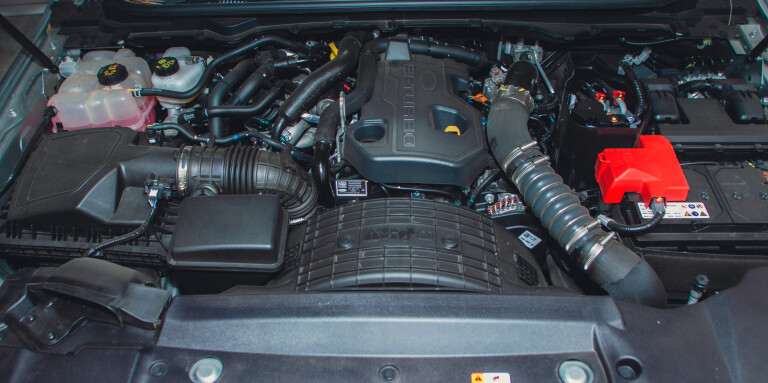
The Everest Trend is offered with two powertrain options, the 3.2- and 2.0-litre turbo-diesels, but our test vehicle was equipped with the newer and peppier 2.0-litre Bi-Turbo with 10-speed automatic.
This newer powertrain might have dropped in capacity and cylinder count, but it makes up for it in punch. The 2.0 Bi-Turbo puts out 157kW and 500Nm of shove, which when coupled with the 10-speed provides a compelling performance upgrade for the more than two-tonne wagon.
The long-serving 3.2-litre five-cylinder turbo-diesel has quite the following and is still a valid choice for some buyers, if frequently towing heavy loads for example. It lugs along without a care in the world and, in my opinion, has a distinctive sound the little four-cylinder can’t match.
However, the 2.0 Bi-Turbo has proven itself as a strong engine across the last few years and is significantly more refined, sips less diesel, and offers up more grunt. Plus, it’s less than two grand more for the newer powertrain, making it a no-brainer.
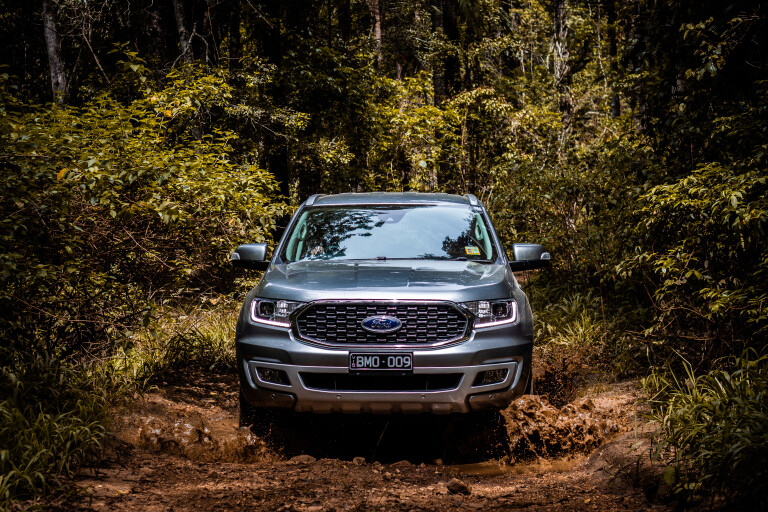
Claimed fuel consumption from Ford for the 2.0-litre Bi-Turbo is 7.0L/100km, which is fairly optimistic given our week of testing both on and off-road landed us at 9.2L/100km. We’ll blame the off-road work, though, because the number hovered between 8-9L/100km for highway and light around-town use.
For regular around-town and adventure duties, fuel capacity is adequate. The 80-litre fuel tank is a bit of a worry if properly adventuring across our expansive country when comparing the Everest to something like the Prado with dual tanks.
The Everest Trend is offered in rear-wheel drive or constant four-wheel-drive configurations, the latter being what we tested.
Ford’s Terrain Management System (TMS) is a beaut dial-operated piece of tech that offers normal, grass/gravel/snow, sand, and rock modes for all four-wheel drive Everest models.
Depending on the drive mode selected, TMS controls torque bias from front to back, as well as adjusting throttle sensitivity and gear shifts. Sand mode, for example, keeps revs high by holding gears and allows more wheelspin to keep things moving along. By contrast, gravel mode upshifts early to limit traction loss. The most extreme, rock mode, engages low-range and holds first gear for longer.
The inclusion of an electronically locking rear diff on 4x4 models is a perk and gives the already capable wagon some extra chops off-road. The locking diff may be overkill for many owners but it’s a case of better to have it and not need it than need it and not have it!
Nitty Gritty

Being a big 4x4, many Everest owners will tow, load it to the brim and take it off the beaten track – possibly all at once – so let’s talk numbers.
The Everest Trend 4x4 weighs in at 2,417kg and with a GVM of 3,100kg, that leaves a healthy 683kg payload.
You’ll need to drop the third and perhaps even the second row, too, if you want to get anywhere near that much gear on board.
Mind you, five adults with a couple of eskies and some camping gear would get you pretty close to 600 kegs.
Interested in towing a caravan? The 3,100kg braked towing capacity falls short of the 3500kg dual-cab ute norm, but is up there with the best in this class and should be plenty unless you plan on pulling a small house.
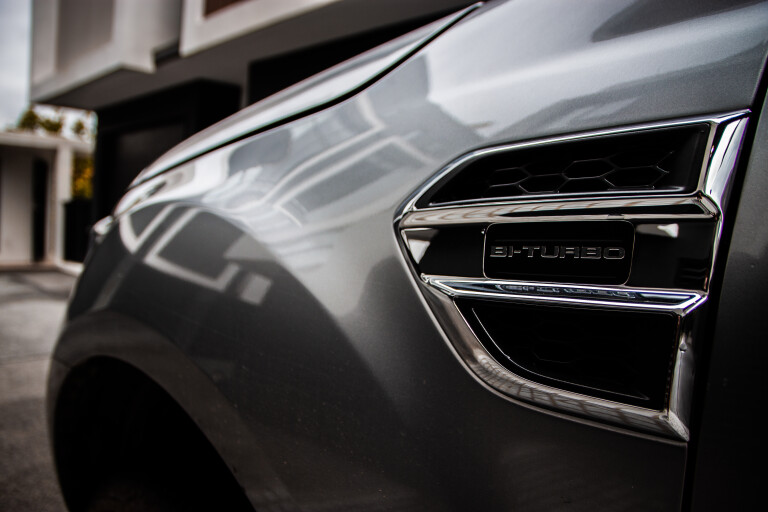
There’s no standard tow pack, which we weren’t fussed by, but it would be a pleasant addition given the hefty towing capacity.
Ford claims the Everest has no fewer than 30 stowage areas totalling 48L, so you’re unlikely to find yourself short of storage. No, we didn’t find all 30 but feel free to.
Up back, cargo space behind the third row is just 249L, which is enough for a few school bags and some other bits and bobs but not much more.
However, the volume jumps to an expansive 876L with the third row folded and a pretty damn handy 1,796L with the second and third row both laying flat.
We squeezed a decent-sized dining table in the test vehicle no worries, despite a group guesstimation suggesting there was “no chance” it’d fit.
For those wanting to get down and dirty, and it’d be rude not to, the Everest Trend 4x4 is a formidable steed off-road.

At 227mm off the ground, the Everest has plenty of clearance for a factory 4x4 and didn’t bottom out on any of the moderate tracks we took it down.
An approach angle of 29.5 degrees, departure angle of 25 degrees and ramp-over angle of 21.5 degrees kept us out of trouble, too.
Lastly, maximum wading depth comes in at a claimed 800mm but we didn’t get close to that because the tracks we were on are known for deep boggy mud beneath the unsuspecting “puddles”.
How’s it drive, then?
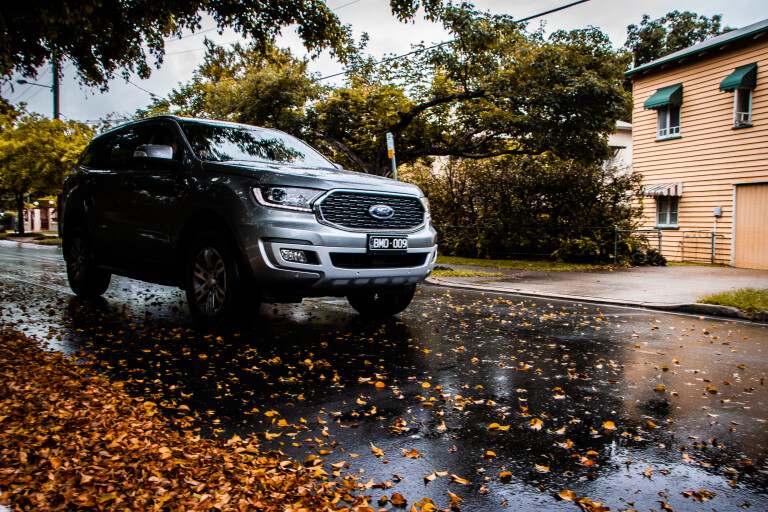
The Everest is a proven package but it had been a few years since I’d driven one for any amount of time and I’d never taken one off-road.
The first thing I was reminded of is that the little 2.0-litre Bi-Turbo diesel punches well above its weight, offering a level of refinement the still-offered 3.2L five-pot turbo-diesel doesn’t both on and off-road.
When I first drove the 2.0-litre donk, back when it was launched, I was wary of its milk bottle displacement, but as we’ve all warmed up to small capacity, high-output diesel motors, I’ve come to appreciate the 2.0-litre option.
Would I option this over the 3.2-litre lugger? Yes, primarily due to its refinement. Of course, it’s also a less thirsty beast despite making more power and torque just about everywhere.
Around town it’s no slouch, with no discernible lag either, thanks mostly to the 10-speed auto that keeps the turbos singing.
The 10-speed auto does take a bit of getting used to, though, if accustomed to lesser-cogged boxes.

Small throttle inputs are your friend and there’s really no need to stab at it for a quick downshift. As has been mentioned countless times in countless drive reviews over the years, the 10-speed hunts and trips over its laces looking for the right gear at times.
While I’m normally open to additional ratios, the 10-speed feels a tad over-cogged and that’s particularly apparent in urban scenarios where the ample torque has the ‘box jumping two, sometimes three, gears at a time.
Constant 4x4, with an electronic centre diff that sends power to the front or rear depending on the scenario, and four simple drive modes make for easy off-road operation. And it's a clear off-road performer, straight out of the box, taking out the 4x4 Australia 4x4OTY title back when it was released in 2016.
The electronic power-assisted steering is spot on with three turns lock to lock, and while slightly vague off centre, it’s better than most 4x4s on-road.
A gripe, as mentioned earlier, is the lack of reach adjustability on the steering column. Those with short-armed, long-legged body types like mine, may have to settle for cramped legroom or over-extended arms as a middle ground compromise.
The on-point steering complements the smooth ride, with minimal body roll compared to other ute-based wagons thanks to a dialled-in chassis.
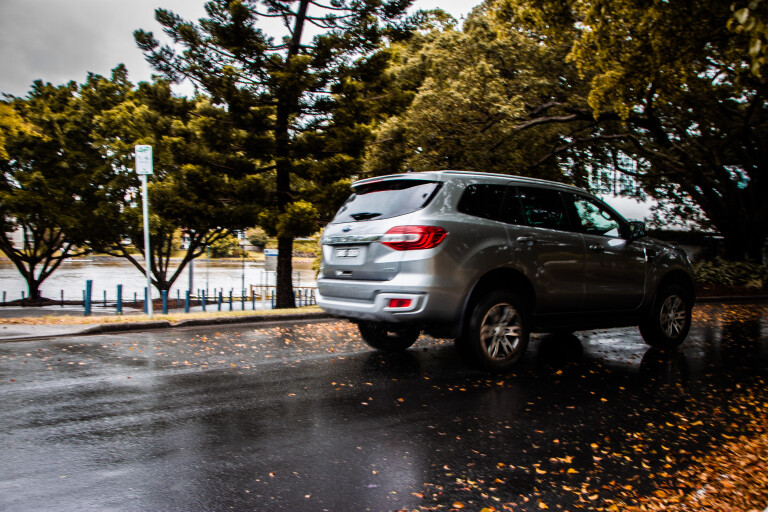
Plush coil-spring suspension all round, with Watt’s linkage and a tough solid axle up back, make the Everest a far less jarring ride than its brutish tray-back brother.
It’s most apparent on corrugated dirt tracks, where the Everest eats up the rough terrain better than any leaf-sprung ute ever would.
From the driver’s seat, the tech offers a suitable mix of safety and operator autonomy, with one of the less invasive safety packages on the market. Drive normally and you won’t even know the safety tech is there, with audible alerts well before the car steps in.
Lane departure is particularly unobtrusive, kicking in less urgently than other systems, so it doesn’t feel like the car is constantly trying to take over. So often you hear of people turning the safety tech off to prevent it from wrestling with them.
Given the Everest is likely to spend much of its life in urban environments, it’s got a fantastic reversing camera with accurate reference points as well as front and rear parking sensors that don’t send you into an auditory-induced panic attack.
Visibility all-round is good and it’s an easy vehicle to acclimatise to.
I’ve already made mention of the fantastic SYNC 3 infotainment system, but I’ll stress again that I actually used it on its own a lot of the time over the usual Apple CarPlay.

It’s a simple, responsive, pleasing system to use and everything is where it makes sense being.
The Active Noise Cancellation Ford fits to the Everest, which uses microphones to monitor cabin noise and make adjustments, seems to do what it’s there for. It’s a pretty quiet cab, most noticeable off-road.
And speaking of off-road, it really is where the Everest 4x4 models shine. What better excuse to test the TMS tech than hitting some mild-ish tracks an hour north of Brisbane at Mt Mee.
Experimenting with the Terrain Management System (TMS) drive modes made a noticeable difference to shifting characteristics, lugging in higher gears and short shifting to prevent traction loss.
The constant 4WD does its thing, allowing you to simply drive from bitumen onto dirt without a single button press, though it does also feature low-range and that electronically locking rear diff I mentioned earlier.
It also has hill descent control that, despite requiring a Jesus-take-the-wheel level of trust that I’ve never got my head around, prevents the awful ABS shudder typically associated with steep brake-riding descents.
The only climb the Everest struggled to do was up a rocky hill we wanted a photo atop. And in that scenario pace wasn’t quite enough, so 4L and the diff lock got it done.

That said, it may not be that useful to throw the Everest into low range unless pushing the limits of what this rig is capable of because it did most things without needing 4L. And that’s on the road-biased stock Bridgestone Dueler tyres that will probably be the first limiting factor.
If you do, however, happen to fit decent off-road rubber and want to throw the Everest at gnarlier climbs, Rock mode engages low-range and holds first gear for longer – fairly pointless on stock rubber and for the tracks we hacked around on, but great if upping the gnarl-factor.
Driving onto a 4WD track without having to go from two- to four-wheel-drive might feel odd for those used to traditional part-time systems. But aside from preventing the uninitiated from blowing up a transfer case, it also eliminates tail wagging on loose or damp surfaces.
Mild understeer becomes apparent when pushing, as is the curse of sending drive to all four wheels, but it’s a safer pick as a family SUV over rear-driven part-time 4x4 options in the market.
Value and Ownership

The as-tested price for the Everest Trend 4x4 is $63,590 before on-road costs made up of the $62,390 base price, with prestige paint at $650 and the premium pack at $550.
Ford offers a five year/unlimited-kilometre warranty for all Everest models, with servicing coming around every 15,000km/12 months.
It’s not the cheapest in its class, falling closer to the Prado in price than other ute-based 4x4 wagons, but it’s an immensely good package.
Our pick for the Everest Trend would be the 2.0-litre Bi-Turbo with 10-speed automatic, especially given next year’s Ranger is set to drop the 3.2-litre engine.
2021 Ford Everest Trend 4x4 specifications
| Body | Five-door wagon |
|---|---|
| Drive | Full-time 4x4 |
| Engine | 2.0-litre Bi-Turbo Diesel |
| Transmission | 10-speed automatic |
| Power | 157kW @ 3750rpm |
| Torque | 500Nm @ 1750-2000pm |
| Weight | 2417kg |
| L/W/H | 4903/2180/1837mm |
| Wheelbase | 2850mm |
| Ground clearance | 227mm |
| Tracks | 1560/1564mm |
| Turning circle | 11.7-metres |
| Payload | 683kg |
| Towing capacity (braked) | 3100kg |
| Fuel tank capacity | 80l |
| Fuel Economy (claimed) | 7l/100km |
| Fuel Economy (as tested) | 9.2l/100km |
| Front suspension | Independent coil springs |
| Rear suspension | Solid rear axle with Watt’s linkage and coil springs |
| Steering | Electronic power-assisted steering |
| Brakes | Discs (f) Discs (r) |
| Wheels | 18-inch Alloy |
| Tyres | 265/60R18 A/S |
| As Tested Price | $63,590 (plus on-road costs) |
Score breakdown
Things we like
- Cargo space with seats down
- SYNC3 infotainment system is a winner
- Extremely competent off-road
Not so much
- Appearance has barely changed for years
- 10-speed automatic hunts for the right gear at times
- No reach adjustability for steering wheel

COMMENTS